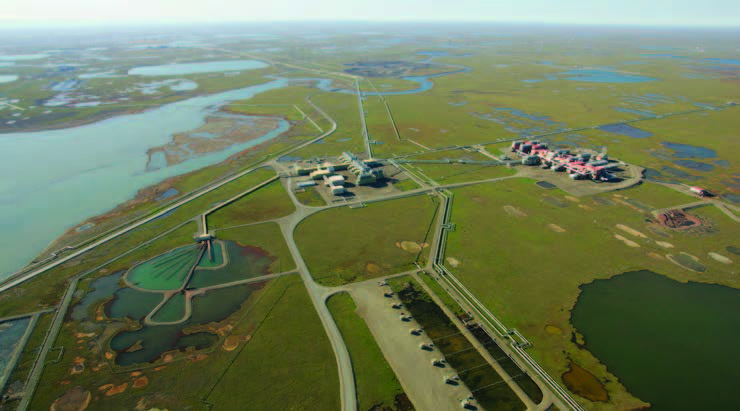Grappling with low oil prices and
federal obstacles to Alaska development
By Kara Moriarty
“Everything old is new again.” That statement is in reference to the all-too familiar reality of grappling with low oil prices and federal obstacles to development. The speed and degree of the decline in oil prices took most of us by surprise, and not in a good way. President Obama’s recent moves to further restrict ANWR and Off shore drilling is also familiar and unwelcome news.
What gets lost in the discussion about the state’s budget shortfalls and resulting spending cuts is a gratifying reality: Alaskans’ decision to keep the new tax law provided an unexpected benefit to citizens − more tax dollars. Because the new tax law raised the base tax rate, the State of Alaska is collecting more in revenue than it would have if we had repealed the law and returned to the old one, ACES. Recently, financial analysts told members of the Legislature’s Senate Finance Committee that indeed, the new tax law generated an additional $380 million this fiscal year, and, assuming oil prices stay the same, another $550 million next year.
Some have argued that despite the additional tax revenues, Alaskans are still getting a raw deal because the state is giving away more in tax credits than it receives in revenues. If you look only at production taxes, that statement is true. But when you add in all the taxes the industry pays to the state via property taxes, corporate income taxes, and royalties, then the revenues received far exceed any tax credits. Add in the fact that tax credits are working as designed to pull more oil and gas out of Cook Inlet, where most of Southcentral Alaska gets its lights and heat, and to incentivize the new or small oil companies now doing business on the Slope, and the credits are still wise policy.
I spent a fair amount of time last summer debating those with the Yes on 1 campaign, who labeled the new tax law a “giveaway” to oil companies. Their arguments were solely focused on production taxes, and what they thought the State of Alaska would lose in revenues. Given what we know now, it turns out that keeping ACES would have been the real giveaway, to the tune of almost a billion dollars over two years, according to analysts. I imagine even critics of the tax law are breathing a private, collective sigh of relief that the new tax law was allowed to stand.
One of the messages I have been repeating for years is that a lot of the state’s problems would be solved with more oil moving through TAPS. A lot of the excitement around the new tax law was the belief that a more attractive investment climate would lead to new projects, which would lead to more oil. After all, in a low oil price scenario, it would be helpful to make up some portion of the shortfall on volume. Well, for the first time in decades, the Department of Revenue predicts oil production decline first to flatten out, then actually increase in the next few years. It takes a lot of work and industry investment to turn decline around, especially in aging fields, but the analysts at Revenue say the expected gain is because of increased company spending on North Slope projects.
Then-Acting Revenue Commissioner Marcia Davis said in a December report, “Given the forecast in investment trends, we expect that oil production should remain above 500,000 barrels per day for the next three fiscal years. Greater investment by the oil and gas industry on the North Slope and solid performance of state investments make Alaska’s overall financial health sound.”
Advocates of tax reform also said it would be much more likely that companies would invest more in Alaska if the financial framework improved. So far, that rule of economics is bearing itself out. Despite low oil prices, companies are still responding to the new tax policy with new projects. Newcomer Caelus Energy Alaska is preparing to spend a billion dollars on a new field that will produce thousands of barrels of new oil every day. Repsol is still moving ahead with its drilling program, and legacy producers like BP continue to advance their projects on State-owned land where the tax law applies. A prolonged period of low oil prices will present new challenges, but for now, projects announced since tax reform passed are still advancing.
In a remarkable display of what a competitive tax structure will do, the State of Alaska recently held the largest North Slope lease sale in two decades. Numerous companies, both familiar and new, bid for the opportunity to explore and produce oil on the North Slope. It’s not difficult to see the link between a new tax policy that makes Alaska a good place to do business, and a lease sale to remember. Companies are responding to the policy, as we hoped they would.
In spite of all this positive momentum, we Alaskans are up against a familiar obstacle, the federal government and its unrelenting appetite for Alaska’s resourcerich lands. In the span of just a few days, the Obama administration took steps to further restrict federal offshore oil leases, and to ban permanently any development in ANWR’s 1002 area, the very portion of the refuge that was set aside for such a purpose. Alaskans are right to be outraged by these decisions, as our very economic future depends on our ability to safely and responsibly develop our own resources.
I am confident that by working together, we can make our voice heard and chart a course toward resource-based economic prosperity for all Alaskans.

Despite low oil prices, North Slope explorers and producers are moving forward with new projects, encouraged by oil production tax reform. As a result, production is expected to increase.

Kara Moriarty is President and CEO of the Alaska Oil and Gas Association. She is also a member of the RDC Executive Committee.
Return to newsletter headlines